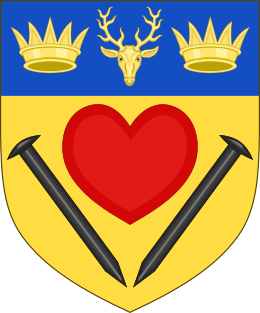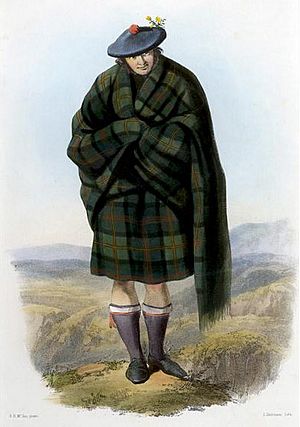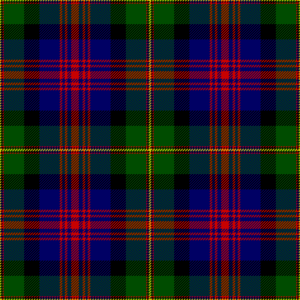Clan MacLennan facts for kids
Quick facts for kids Clan MacLennan |
|||
|---|---|---|---|
| Mac Gille Fhinnein | |||
| Motto | Dum spiro spero While I breathe I hope. | ||
| Profile | |||
| Plant badge | Furze | ||
| Chief | |||
 |
|||
| Ruairidh Donald George MacLennan of MacLennan | |||
| The Chief of the Name and Arms of MacLennan | |||
|
|||
|
|||
Clan MacLennan, also known as Siol Ghillinnein, is a famous Scottish clan from the Highlands. They lived in the north-west of Scotland a long time ago. The name MacLennan comes from Scottish Gaelic. It means Mac Gille Fhinnein, which means "son of the follower of St Finnan".
Contents
History

Where the Clan Began
The MacLennans settled around Kintail in Scotland. Their name comes from old church traditions. In the past, people would dedicate themselves to a saint. They would use the saint's name with "Maol" or "Gillie" before it. "Gillie" means "servant".
Many Highland names are formed this way, like Malcolm or Gilchrist. When these names became surnames, the "Gillie" part was often dropped. For example, Mac Gille Fhinnein became MacLennan.
The MacLennans have a very old history. An important church leader named Abbot MacLeinan died in 776 A.D. He was buried on the Isle of Bute. In 1217, a special document from King Alexander II mentioned Duncan MacLennan. He might be the start of the MacLennan family branch.
Early Battles
In 1372, the MacLennans faced a big defeat. They were fighting against the Frasers and MacRaes of Aird. This battle happened at Drumderfit. This is why the clan's war cry is "Druim nan Deur", which means "Ridge of Tears".
The MacLennans had raided towns like Tain and Chanonry. Then they camped on a hill near Munlochy. The Laird of Lovat, a Fraser chief, gathered his fighters. They surprised the MacLennans early in the morning at Drumderfit. Almost all the MacLennans were defeated. Only one person escaped by hiding under a large basket. His family later took the name Loban or Logan. They still live in that area today.
15th Century Conflicts
The MacLennan clan's shield shows their connection to the Clan Mackenzie. The MacLennans and Clan Macrae were strong allies of the Mackenzies. They might have even guarded the Mackenzie's castle at Eilean Donan at one time.
In 1452, the MacLennans fought in the Battle of Bealach nam Broig. They were allies of the Clan Mackenzie of Kintail. They fought against the Frasers, led by Lord Lovat, and the Munros of Foulis.
This was a very fierce battle. It started because some Mackenzie allies tried to capture the Earl of Ross. The Earl's son was later captured by the Mackenzie's followers. The Earl of Ross asked Lord Lovat for help. Lovat sent 200 men, who joined the Munros and Dingwalls. They caught up with the western clans at Bealach nam Broig.
A bloody fight followed, made worse by old rivalries. The MacLennans and their allies were completely defeated. The Dingwall family lost many men. The Munro family of Fowlis also lost many important members.
17th Century and the Civil War
During the Civil War in the 1600s, the Clan MacLennan became well-known. They were loyal followers of the Mackenzie chief. The Mackenzie chief supported the Covenanters. These were people who fought against King Charles I's royalist army.
The MacLennans and Mackenzies fought against the royalists in the Battle of Auldearn in 1645. But they were defeated. At this battle, the MacLennans were led by their chief, Ruaridh. He was a very tall man with a red beard.
The royalist commander, James Graham, the Marquess of Montrose, was outnumbered. But he was a brilliant leader. He tricked the Covenanters about where his main army was. This made the Covenanters attack in the wrong place. Montrose then outflanked the Covenanters, turning the battle in his favor.
The MacLennans were told to retreat, but the message never reached them. Chief Ruaridh and his men fought bravely until the very end. They defended the Mackenzie flag. They were finally defeated by the Clan Gordon cavalry.
18th Century and Jacobite Risings
After losing so many men, the Clan MacLennan played a small part in the Jacobite risings. These were attempts to bring the old royal family back to the throne. After the Battle of Culloden, eleven MacLennans were taken prisoner.
After Culloden, the traditional clan system began to break down. Many MacLennans moved to new lands. Today, there are MacLennan Mountains in New Zealand. There is also a McLennan County in Texas, USA.
Clan MacLennan Today
For over 300 years, there was no recognized MacLennan chief. Then, in 1977, Ronald George MacLennan was recognized as the clan chief. This was done by the Lord Lyon King of Arms, who is in charge of Scottish heraldry.
However, another man named William MacLennan from Australia came forward. He had proof that he was directly related to the older line of the clan. The Lord Lyon King of Arms gave him the right to use the clan's symbols. But William did not try to take Ronald MacLennan's place as chief.
After Ronald passed away in 1989, his son, Ruairidh Donald George MacLennan of MacLennan, became chief. He was only 13 years old, making him the youngest clan chief in Scotland.
In 1990, William MacLennan's son continued the challenge for the chiefship. The issue was finally settled in 2000. William's son decided to drop the legal challenge. This brought an end to the dispute over who should be chief.
Today, Clan MacLennan has active groups around the world. You can find them in Scotland, Australia, Canada, the USA, and New Zealand. The current clan chief lives in Dores, Inverness, Scotland.
Clan Profile
- Clan chief: The current chief is Ruairidh Donald George MacLennan of MacLennan. He is the Chief of the Name and Arms of MacLennan.
- Chiefly arms: The chief's coat of arms has a gold background. It shows a red heart between two black passion nails. At the top, there is a blue band with a stag's head and two old crowns, all in gold.
- Chief's war cry: Druim nan deur. This means "the ridge of tears" in Scottish Gaelic.
- Clan member's crest badge: Clan members can wear a badge with the chief's crest and motto. The crest shows a piper wearing the MacLennan tartan. There is also another crest with an arm holding a sword.
- Motto: The clan motto is Dum spiro spero. This is Latin for "while I breathe I hope".
- Clan badge: The plant badge for Clan MacLennan is furze.
- Clan tartan: Clans MacLennan and Logan share the same tartan pattern. It was first recorded as mostly blue. The MacLennan tartan has specific thread counts of yellow, black, red, green, and blue.
See also
- MacLennan, list of notable MacLennans


